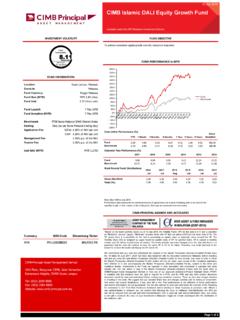Transcription of Palm Oil Industry in Malaysia - World Bank
1 Palm Oil Industry in Malaysia Skills & Knowledge for Sustained Development in Africa 24 June 2009. 1. 1. Origin of Palm Oil The oil palm tree (Elaeis Guineensis Jacq.) originated from West Africa in a belt from Angola to Senegal. The earliest archaeological evidence on palm oil consumption was found in an Egyptian tomb in Abydos. As no palm oil was produced in the country, the evidence implied that the oil had been traded during the time of the Pharaohs, 5,000 years ago Original steps to extract palm oil Harvesting Cooking to Separate Softening Pressing Oil collection fruit sterilise fruit fruitlets the out oil bunches bunches from the fruitlets bunch The oil palm tree (Elaeis Guineensis Jacq.) originated from West Africa with a history of consumption dating back to 5,000 years. Today it feeds ~3 billion people in 150 countries. 2. Source: MPOC Publications Global Palm Oil Industry Today, palm oil is one of the 17 major oils traded in the global edible oils & fats market.
2 Palm oil can be found in one out of every ten food products worldwide. Key importers of palm oil today are China, India, EU-27 & Pakistan. Global vegetable oil supply (M MT). 250. 952. 1,000. 3%. 3%. Supply Growth 207 1,840. 200 6%. (2010 -2020F). 14% 11,748. 161 17% 40%. 150 14% 4,532. 15%. 129. 121 13% 29%. 15% 16% 16%. 100 16% 33% 5,223. 17%. 35%. 33% 50. 46% 40% 4,694. 34% 16%. 35%. 0 China EU-27 India Pakistan Bangladesh United States 2008 2010F 2015F 2020F. Others Palm Oil Soybean Oil Rapeseed Oil Others World Palm Oil Imports(2008). Palm oil is expected to make up 34-46 % of vegetable supply (2010-2020F). Source: LMC Oilseeds Outlook for Profitability to 2020 (Jan 2009), USDA Database April 2009 3. Palm Oil Value Chain & Applications Downstream Consumer Upstream Midstream Processing Products ACTIVITIES. Seed Trading Refining Packaging and production Crude palm oil Fractionation branding Nursery bulking Oleochemical Food products Cultivation Esterification Non-food products Harvesting Refined product Milling storage PRODUCTS.
3 DxP seeds Crude palm oil RBD Palm Oil Cooking oil, frying fats Fresh fruit bunches Palm kernel Palm Fatty Acid Distillate Margarine Crude palm oil Crude palm kernel RBD Palm Olein Shortening Palm kernel oil RBD Palm Stearin Vanaspati Biomass (Empty Palm kernel cake RBD PK Olein Ice cream, non-dairy Fruit Bunches, RBD PK Stearin creamers kernel shell, fronds) Cocoa Butter Equivalent Candles, soap Palm oil mill effluent Emulsifiers 5. 7. 9. 1. 3. 5. 7. 9. 1. 3. 5. 7. Cocoa Butter Substitute 97. 97. 97. 98. 98. 98. 98. 98. 99. 99. 99. 99. 20%. /1. /1. /1. /1. /1. /1. /1. /1. /1. /1. /1. /1. 45,000. Cocoa Butter Replacers Vitamin E supplements 74. 76. 78. 80. 82. 84. 86. 88. 90. 92. 94. 96. 19. 19. 19. 19. 19. 19. 19. 19. 19. 19. 19. 19. 40,000. Fatty acid, alcohols, Confectionery 35,000. Food Use Non-Food Use 30,000. amines, amides Bakery fats 25,000. Glycerines Biodiesel 20,000 Palm methyl esters Energy generation 15,000 Tocotrienol Animal feed 10,000 Organic fertiliser from 5,000 biomass 0 80%.
4 5. 7. 9. 1. 3. 5. 7. 9. 1. 3. 5. 7. 9. 1. 3. 5. 7. 9. 1. 3. 5. 7. 96. 96. 96. 97. 97. 97. 97. 97. 98. 98. 98. 98. 98. 99. 99. 99. 99. 99. 00. 00. 00. 00. /1. /1. /1. /1. /1. /1. /1. /1. /1. /1. /1. /1. /1. /1. /1. /1. /1. /1. /2. /2. /2. /2. 64. 66. 68. 70. 72. 74. 76. 78. 80. 82. 84. 86. 88. 90. 92. 94. 96. 98. 00. 02. 04. 06. 19. 19. 19. 19. 19. 19. 19. 19. 19. 19. 19. 19. 19. 19. 19. 19. 19. 19. 20. 20. 20. 20. These days, palm oil and derived products are channeled into worldwide industrial and commercial activities to churn out food products as well as non-food applications. 4. Source: MPOC Publications, USDA Database Palm Oil Benefits Versatile Healthy As the cheapest traded edible oil, palm oil Balanced composition of saturated can be used for food and non-food and unsaturated fatty acids purposes Saturated palmitic acid (44%), Examples of food use Monounsaturated oleic acid (40%). Cooking Oil Polyunsaturated fatty acids (10%).
5 Shortening Can be blended with other soft oils to Margarines meet AHA1 recommended ratio of Vanaspati 1:1:1 (saturated, monounsaturated, and polyunsaturated fatty acids). Cocoa butter substitutes High carotene content Key ingredient in instant noodle production 15x higher than carrots Examples of non-food use 50x higher than tomatoes Oleochemicals Cholesterol-free, no risk of trans fatty acids Biodiesel Does not require hydrogenation in Energy generation food use Contains vitamin E. Highest content of tocotrienols among edible oils Also contains tocopherols Meets the FAO/WHO Food Standard requirements under the CODEX. Alimentarius Commission Programme. 1. American Heart Association Source: MPOC publications 5. Palm Oil Benefits Sustainable Compared to other oilseeds, the oil palm tree: Has the highest oil yield per ha Requires the lowest fertiliser inputs (~1MT of fertiliser per planted ha).
6 Productive cycle of ~25 years RSPO-compliant producers are required to meet specific environment & social criteria Eco-friendly practices Wastage from plantations are reused EFB mulched as fertilisers back in estates Palm kernel shells biomass feedstock at mills for steam generation Palm oil mill effluent biogas for electricity generation Not only does palm oil have the potential to feed World due to its abundance, but it is also a versatile, healthy and a sustainable source of oil. Source: MPOC publications 6. Oil Palm Cultivation Area Physical Conditions for Oil Palm Planting - Prime Area - Plantable Area Plantable = +/- 10 degrees off the equator. Prime areas = +/- 5 degrees off the equator. Located within the equator band Humid tropical climate Temperature range of 24-32 C throughout the year . Ample sunshine (~ 5-7 hours a day in all months). Evenly distributed annual rainfall of ~ 2,000mm Soil pH < Relative humidity ~ 85%.
7 No stagnant water Oil palm hectarage in Malaysia has grown from 320,000 ha in the 1970s to over 4million ha today t Source: MPOC publications, The Oil Palm 4 edition by Corley, Tinker 7. Oil Palm Cultivation Area 6 , 0 00. Global oil palm mature areas: 5,000. ha in 2007 5 , 0 00. Oil Palm Mature Area (000 Ha). Indonesia: ha 4 , 0 00. 3,900 (2007). Malaysia : ha 3 , 0 00. Other oil crops Soybean : ha 2 , 0 00. Groundnut : ha 1,282. Sunflower : ha 1 , 0 00. 450 405. 230. Rapeseed : ha 0. Indonesia Malaysia Thailand Nigeria Colombia Oth countries Rapeseed Average lifespan of a oil palm tree ~25. Sunflower years Groundnut Palm clones planted in Malaysia &. Indonesia : Tenera Soybean oil Palm oil = X. Oil Yields (MT/Ha). Tenera Dura Pisifera Relative to other oilseeds, the oil palm tree is the highest yielding oil crop at an average yield of Source: Oilworld Database (June 2008) 8. Palm Oil Industry Against Economic Cycles Historical GDP growth and CPO Prices (1980- 2008).
8 3,000. There has been several recession periods since 2,500 1980. GDP Growth (%). Dot-Com Crash Price (RM/MT). 2000-2002. 2,000. CPO prices cycles have been influenced by 1,500 supply and demand dynamics impacted by 1,000 economic conditions US Recession Recession 500 However Malaysian 1982. 1990-1991. Asian Financial Crisis palm export data has 1997-1998. 1980 1982 1984 1986 1988 1990 1992 1994 1996 1998 2000 2002 2004 2006 2008. 0 shown historical upside trend World GDP Growth Msia GDP Growth CPO Price As a food necessity, Malaysia palm oil export data (1980-2008) demand for palm oil has always been on increasing trend due to World population growth. Outlook on CPO prices Million MT. expect to range between RM2,000- 2,300/MT (US 570- 660/MT) by end of 2009. 1980 1982 1984 1986 1988 1990 1992 1994 1996 1998 2000 2002 2004 2006 2008. Msia Palm Oil Export Volume Historical data shows that demand for palm oil as a food product has always been increasing despite peaks and troughs in economic cycles Note: IMF regards periods when global growth is less than 3% to be global recessions.
9 Source: MPOB website, OECD Financial Indicators database 9. Palm Oil Production & Midterm Prospects Palm Oil Production (M MT). 100 90 Supply Growth (2010 -2020F) 80 70. 60 50. 40 30 20. Indonesia Malaysia Thailand Colombia Rest of the World 10 Total Production = 43m MT. 0. 2008 2009F 2010F 2015F 2020F. World Palm Oil Production (2008) Indonesia Malaysia Thailand Colombia Rest of the World At a forecasted supply growth of 8%, palm oil is well positioned to meet global food and non- food demands. Malaysia is the second largest producer and leading exporter of palm oil. Source: LMC Oilseeds Outlook for Profitability to 2020 (Jan 2009). 10. Economic Importance To Malaysia Today, the palm oil Industry has become a key economic growth driver in Malaysia Second largest contributor to 2008 external trade (~ at RM 46bn). Direct employment ~570,000 people Estimated total employment ~860,000 (incl. downstream).
10 Electronics &. electrical products Sector No. Capacity Others (MT/annum). FFB Mills 408 Palm Kernel 41 Crushers Refineries 50 Oleochemical 17 Chemicals & chemical Palm oil products Crude oil and Liquefied natural gas condensates (LNG) Malaysia External Trade (2008). Total= RM663bn The palm oil Industry has been a key economic growth driver by creating jobs and triggering downstream activities to bring in revenue for national development and stability, especially Malaysia & Indonesia Source: LMC Oilseeds Outlook for Profitability to 2020 (Jan 2009). 11. History Of The Malaysian Palm Oil Industry TODAY. Key Milestones 1970s-1980s Market Expansion &. Product Diversification 1960s Industrialisation &. Origin Refining Malaysia and 1917. Crop Indonesia are Diversification 1970s: top palm oil 1800s producers Expansion of Oil Palm 1960s: domestic Existence of Commercialisation Malaysia refining & World 's largest Oil Palm increased First fractionation listed Introduction cultivation facilities plantation commercial pace of oil company via planting in 1980s: 1875: palms the Synergy Tennamaran Malaysianisation Introduced to Introduction of Drive2 merger Estate, of 3 plantation Malaya by the land China, India, &.
















